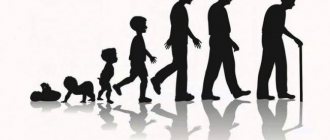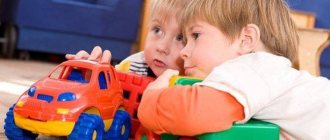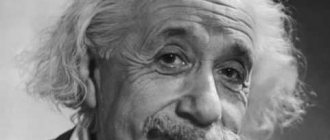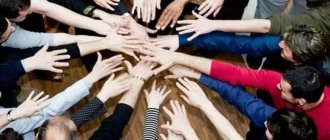Socialization of an individual is a person’s mastery of basic social norms, values, culture, standards of relationship models in the society to which the individual belongs. It consists of accepting and mastering the values, morals, norms of behavior, and knowledge prevailing in society. Socialization contains agents and institutions that specialize in the processes of introducing an individual to society.
Socialization is divided
:
- Primary – mastery of a basic set of values and behavior patterns in society by a child;
- Secondary – mastery of a new value-normative basis by an adult individual.
Features of permanent socialization
Primary and secondary socialization - what is it?
Human life is changeable. The socialization of the individual, having originated in one life environment, can continue and take place in changed conditions. Moving to another city, country, changing profession or new team - all this affects the further development of socialization.
Attention! The ability of an individual to adapt to constantly changing social conditions is called permanent socialization.
It is natural if life changes systematically and measuredly. But during revolutionary changes, when one social system collapses and another arises, many citizens cannot cross new boundaries and get used to new foundations. This not only knocks them out of an understandable rut in life, but also throws them to the sidelines of life, causing irreparable moral trauma.
An example is the internationalist warriors. Fulfilling their international duty in Afghanistan, they returned from the war to a completely different country. Market relations, the collapse of the economy, and rampant crime were so different from what they “protected,” losing lives and health, that many were never able to recover morally. There was no housing, no work, and to complaints and questions, officials from the new government answered: “We didn’t send you there!” Not all military officers were able to step over honor and conscience and choose one of the options: go into business or join one or another criminal group.
Components of the socialization process.
Firstly, spontaneous socialization occurs in the interaction of a person with society as a whole and with its individual segments (as discussed above), including with the state and government organizations as segments of society.
Relatively guided socialization of a person occurs in the process of interaction with the state and state organizations as structures that manage society and its citizens.
Secondly, spontaneous socialization is unintentional, while relatively guided socialization is determined by state policy and legislation, as well as their implementation in the social practice of the state, its administrative entities and municipalities.
Relatively socially controlled socialization Relatively socially controlled socialization
-
education, which can be defined as the relatively meaningful and purposeful cultivation of a person in accordance with the specific goals of the organizations and groups in which it is carried out.
A person’s upbringing is carried out in the process of his interaction in several segments of society. Firstly, education is carried out in the family, i.e. family education takes place
Secondly, education is carried out by religious organizations, i.e.
religious education
takes place Thirdly, education is carried out by the state and society in numerous, diversified organizations specially created for this purpose (from nurseries and schools to universities and vocational retraining courses), in which
social education is implemented.
Fourthly, education takes place in criminal and totalitarian political and quasi-religious communities.
In this case, we are dealing with dissocial or countersocial education.
Fifthly, there are various types
of correctional education (
from adaptation of autistic children to living conditions to re-education of delinquents).
The difference between spontaneous and relatively socially controlled socialization In the early stages of the existence of any society, as well as in surviving archaic societies, education and spontaneous socialization are syncretic - fused, non-divided.
Education becomes relatively autonomous in the process of socialization at a certain stage of development of each specific society, when it acquires such a degree of complexity that there is a need for special activities to prepare the younger generations for life in society.
Education as a relatively socially controlled socialization differs from spontaneous socialization in at least three ways. Firstly, spontaneous socialization is a process of unintentional interactions and mutual influences.
Social action is the basis of education. The German scientist M. Weber, who introduced this concept, defined it as: an action aimed at solving problems; action specifically focused on the partners' responsive behavior; an action that involves a subjective understanding of the possible behavior options of people with whom a person interacts.
Secondly, spontaneous socialization is an intimate (continuous) process, since a person constantly interacts with society. Education is a discrete (discontinuous) process, because, being systematic, it is carried out in certain groups and organizations, i.e. limited by place and time.
Thirdly, spontaneous socialization has a holistic character, because a person, as its object, in his development experiences the influence of society (positive or negative), and as a subject, to one degree or another, adapts and becomes isolated in interaction with the entire complex of circumstances of his life.
Education is a partial process. This is determined by the fact that a person is raised by his family, religious and educational organizations, certain groups of people, countercultural organizations - they all have divergent tasks, goals, means and results of education. A person in his life passes through a number of communities of various types that educate him and at each period of his life he simultaneously enters several of them. There is not and cannot be a strict connection and continuity between these communities, and often there is no connection at all (which can be both good and bad depending on the circumstances).
Self-change of a person A person does not remain passive in the process of socialization (both spontaneous, and relatively guided, and relatively socially controlled - education). He shows a certain activity, felt or realized the need or desire to change something in himself in order to:
— to a greater extent comply with the expectations and requirements of society, both positive and negative; - to resist, to one degree or another, the demands of society, to more effectively solve the problems that arise in one’s life; - avoid or overcome certain dangers, not become a victim of certain unfavorable conditions and circumstances of socialization; - bring your image of the “present self”
(how a person sees himself in a given period of time) to the image of the “desired
self”
(how he would like to see himself). That is, in the process of socialization a person changes himself in one way or another.
Self-change is the process and result of a person’s more or less conscious, systematic and successful efforts aimed at becoming different (less often completely, usually partially).
Efforts can be aimed at changing: - your appearance and physical qualities; -personal properties; — intellectual, volitional, need, expressive, spiritual, social spheres (knowledge, skills, values, attitudes, etc.); — behavioral scenarios; — image and/or lifestyle; - relationships with oneself (self-esteem), relationships with oneself (self-esteem, self-acceptance), relationships with the world (worldview, worldview - picture of the world), relationships with the world (ways of self-realization and self-affirmation). Self-change can have prosocial, asocial and antisocial vectors. Self-change can be of the nature of: -self-improvement, development, transformation of existing inclinations, traits, knowledge, etc.; - self-construction, cultivation, formation of desirable human properties; - self-destruction of physical, spiritual, personal, social properties (result - alcoholism, drug addiction; physical, spiritual, social degradation).
⇐ Previous5Next ⇒
Recommended pages:
Test on the topic “Socialization of personality”
Test on the topic “Man. Individuality. Personality. Socialization of personality".
1. The qualities of a person as an individual are manifested primarily in:
1) features of thinking and memory 3) the course of mental processes
2) participation in the life of society 4) inherited qualities
2. An individual’s mastery of social norms and cultural values of society represents:
1) the process of socialization 3) social differentiation
2) mobility of the individual in society 4) personal self-realization
3. The following are human needs. all of them, with the exception of two, are social needs. Find two terms that fall out of the general series and write down the numbers under which they are indicated.
1) in work 2) in creation 3) in creativity 4) in mutual understanding 5) in rest 6) in food
4. Modern science identifies three dimensions of human existence: biological, mental and social.
The social dimension includes:
1) inherited developmental features 3) racial differences
2) age characteristics 4) educational achievements
The biological dimension includes:
1) value orientations 2) behavioral skills 3) primary needs 4) knowledge and skills
5. Are the following statements about socialization true? Choose the correct judgments and write down the numbers under which they are indicated.
1. Socialization occurs as a result of the spontaneous influence on the individual of various circumstances of life in society.
2. Socialization occurs as a result of purposeful, including pedagogically organized influence on the individual.
3. Socialization is any socially useful human activity.
4) Socialization is a clash of interests, views, opinions of individual people.
5) Socialization is the assimilation by an individual of the cultural values of society.
6) Socialization is a change in a person’s position on the social ladder
Answer: 125
6. The statement that a person is a product and subject of socio-historical activity is a characteristic of him:
1) social essence 2) biological nature 3) physiological processes 4) temperament
7. In contrast to the behavior of animals, human activities:
1) has an active character 3) has an individual character
2)has an adaptive character 4)has a transformative character
5) aimed at satisfying physiological needs
6) is highly specialized in nature
7) preceded by goal setting Answer: 47
8. A person’s conscious participation in public life characterizes him primarily as:
1) individuality 2) individual 3) creator 4) personality
9. Find a concept that generalizes all other concepts in the series below, and write down the number under which it is indicated.
1) family education 2) additional education 3) socialization of youth 4) schooling 5) labor training
10. Human needs determined by his biological nature include the need for:
1) self-affirmation 2) self-preservation 3) self-development 4) self-esteem
11. Man, unlike animals
1) experiences physiological needs 3) has sensations
2) sets and implements goals 4) creates visual images
12. The main factor in personality formation is:
1) communication with others 2) natural environment 3) mechanism of heredity 4) innate tendencies
13. What sign reflects the qualities of a person as an individual?
1) genetically inherited qualities 3) belonging to the human race
2) manifestation of feelings and emotions 4) orientation towards certain values
14. Mark the correct judgments about the formation of personality?
1. Hereditary, congenital, individual properties of a person do not affect the formation of his personality.
2. The formation of a person’s personality is associated exclusively with social interactions.
Answer:-
15. Below are a number of terms. All of them, with the exception of two, relate to the concept of “human biological needs”. Find two terms that fall out of the general series and write down the numbers under which they are indicated.
1) reproduction 2) self-realization 3) nutrition 4) breathing 5) movement 6) communication 7) rest
14. Fill in the missing words. Each word can only be used once.
“Character characteristics, social abilities and the level of general talent influence one or another direction of development of ___________(A)’s life activity and its viability, efficiency, and ability to work. The rate of growth and maturation is influenced by lifestyle, methods of _____________ (B) (games, sports training), work and social behavior, the presence or absence of stressors, the most important of which are __________ (B), etc. All these factors are important as moments in the formation of ___________(G) subject. The concept of “responsibility” is the most important internal __________(D) of its activities. A sense of responsibility and duty is manifested in a person’s conscious readiness to follow established ________ (E), to evaluate his actions in terms of their consequences for others.
List of terms:
1) society 2) person 3) conflict situation 4) interpersonal relationships 5) activity
6) personality 7) norm regulator 9) sanctions
norm regulator 9) sanctions
253678
Communication is the main factor of socialization
Communication determines the process of socialization. Communication is understood as interaction between people, in which their social relationships are realized.
Communication includes parties interconnected with each other:
- interactive side – organization of interaction between individuals;
- communication side – exchange of information between people;
- the perceptual side is people’s perception of each other as communication partners and the establishment of understanding between them.
Feedback during communication is a message sent to another person and carrying information about how a person feels as a result of communication, how the interlocutor is perceived, what feelings he evokes.
The following means of communication are distinguished:
- language;
- emotional expressiveness, intonation;
- posture, facial expressions, gaze, gestures;
- distance between communicating.
Stages of personality development
Socialization is a process of assimilation by an individual, which occurs gradually and consists of several stages. The following series can be distinguished:
- adaptation – knowledge of basic norms of behavior;
- individualization – manifestation of deviant and antisocial behavior for the sake of personal self-affirmation;
- integration – professional development with the aim of directing creative energy in the direction of interest and searching for colleagues and associates.
Interesting. Sometimes the course of socialization is divided into stages: pre-labor, labor, post-labor. Not all psychologists adhere to this classification, but such a division does occur.
Stages of socialization
His psychological and economic standard of living depends on the socialization of an individual. Conscious or forced asociality interferes with normal existence in society. Lack of support from society, social institutions and the state negatively affects all aspects of human life.









